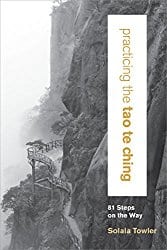
 Practicing the Tao Te Ching: 81 Steps Along the Way, by Solala Towler
Practicing the Tao Te Ching: 81 Steps Along the Way, by Solala Towler
Sounds True, 978-1622036035, 320 pp., 2016
The Tao Te Ching is an ancient wisdom text written in 81 verses and attributed to Lao Tzu, although as Solala Towler points out, Lao Tzu is more likely to be a title than a name. There are many, many versions of the Tao Te Ching out there, but this book brings some very interesting additions to existing material.
Practicing the Tao Te Ching contains all 81 verses of the Tao Te Ching — as translations go, I found it less patriarchal and hierarchical than is traditional. Much of it was more familiar than not, though some verses were fairly unfamiliar, but that seems to be the way of it. One of the book’s first gifts that really struck me is that it talks about the translation process. Moving from Chinese pictogram to English is inevitably going to lead to flawed results. By talking about what a character means and implies in Chinese, the whole process of interpretation and multiple readings really opened up for me. This is a text that can never be properly translated. Even in Chinese it’s full of ambiguity and possibility. I find that really exciting.
In 81 chapters, Towler works through the verses. He suggests not reading the book in order, but reading the verses, then his commentary on the verses, then the practical work. I confess that I didn’t do this. I haven’t been able to do the book justice as a reviewer because it invites deep study and ongoing work with the material. I can say with confidence that this is a book that really does deserve to be worked with slowly over a long time frame and I hope to go back and do that.
For me, the most exciting part of the book was the commentary. For each verse, the author shares something more. It can vary a lot — it may be about the original text or translation, as described above. It may be historical context. For example, I’ve struggled in the past with the way the Tao Te Ching seems anti-intellectual. Many versions discourage book learning and cleverness and — as a bookish person — I’ve found this hard to relate to. However, the author points out that Lao Tzu was writing against a backdrop of Confucianism. That allows me to see the apparently anti-intellectual stance as more of an opposition to the dogmatic thought system of the Confucians.
The commentary sections of the book can also offer wider philosophical material, contemporary and historical. Towler draws on other writers in the Taoist tradition to shed light on the text or expand on ideas, and these provide interesting juxtapositions to the original. Sometimes rather than looking at the history, the author talks about contemporary applications for the text, or ways of rethinking the language of kings and rulers to pertain to how we rule our inner landscapes. I found a great deal to chew on, and very much enjoyed this material.
The third section of each chapter takes the inspiration of the verse and offers a practical activity. The idea is to help the reader make the Tao part of their life, not just an abstract concept. There’s a lot of good meditative work to do, and suggestions that you can apply to everyday living. As much as anything, it’s about developing an outlook on life in line with the principles of the Tao — the Way. How to yield and flow, how to do by not doing (a reoccurring concept that shows up in most translations I’ve thus far encountered.) For anyone seeking a practice more about doing than believing, this is well worth a look.
I have no idea where the practical exercises come from as a whole. Some are clearly drawn from tai chi and qi gong practices. Some are startlingly akin to the kinds of tree meditations I’ve previously only found in contemporary Druidry — ways of working with energy that have the participants visualizing themselves as a tree.
I very much enjoyed reading Practicing the Tao te Ching , and I think its ideas would be of interest to Pagan readers who are looking to broaden their horizons without necessarily wanting to adopt Taoism. In terms of the natural affinity between Taoism and Paganism, a quotation may be the best illustration:
“Tao is not a personified god-figure or creator; instead, the universe and everything in it comes into being of their own accord and sustain themselves the same way… If we follow the natural patterns of life, Lao Tzu says, we become a sage. The natural way is for humans to follow the ways of the Earth. We are part of this Earth, so we need to cleave to it by following the seasons of the Earth, as they manifest within as our own seasons of life.” ((p. 98))
For a Pagan interested in harmonizing with nature, exploring authenticity and being present in the world, Practicing the Tao te Ching has a great deal to offer. After all, we follow the ways of the Earth as well.








